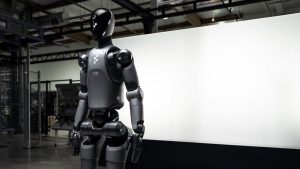4. The world is upside down! China begins to create robots for… See more
China is preparing to enter a new era of artificial intelligence (AI) and robotics, with an ambitious plan to begin mass production of humanoid robots by 2025, according to reports from China’s Ministry of Industry and Information Technology (MIIT) and leading Chinese news agencies such as Xinhua and CGTN.This strategic initiative is part of China’s broader push to become a global technology powerhouse by accelerating advancements in AI, robotics, and intelligent manufacturing. Industry experts and analysts suggest that humanoid robots could become a major driver of industrial innovation, workforce efficiency, and economic growth over the next decade.

Humanoid robots are robotic systems designed to resemble the human body,
either partially or fully, in terms of movement, functionality, or appearance. These robots are typically powered by advanced AI algorithms, machine learning, sensor networks, and robotic actuators to perform complex tasks autonomously or semi-autonomously.Applications for humanoid robots span across:Manufacturing: Performing repetitive or hazardous tasks.Healthcare: Supporting patient care and elderly assistance.Logistics: Automating delivery and inventory processes.Public Services: Serving as receptionists, guides, or security assistants.Education and Research: Acting as learning aids or experimental models.
China’s National Strategy for Robotics Innovation
In 2023, the Chinese government released the “Guiding Opinions on the Development of Humanoid Robots”, a policy document outlining the roadmap for scaling up humanoid robot production and integrating AI into physical labor sectors. According to the MIIT, the country aims to establish a standardized framework for robot design, safety protocols, and intelligent control systems by 2025.The roadmap emphasizes three key goals:Technological Self-Reliance: Reducing dependence on foreign robotics components by nurturing domestic innovation.Industrial Ecosystem Development: Building industrial parks and innovation hubs focused on robotics R&D.Mass Commercialization: Enabling large-scale production of humanoid robots for industrial and commercial use.According to a Reuters report, China’s push aligns with its broader “Made in China 2025” strategy, which focuses on upgrading the nation’s manufacturing capabilities across key sectors such as semiconductors, AI, and robotics.

Here’s what’s really going on 🌍🤖:
China is rapidly scaling up humanoid robot development—and fast. Here’s the breakdown:
✅ 1. State-driven humanoid robot push
-
The Ministry of Industry and Information Technology set a goal to mass‑produce humanoid robots by 2025, with the market projected to reach ¥300 billion by 2035 cctvplus.com+15globaltimes.cn+15en.people.cn+15time.com.
-
In April, Xinhua reported Moga Technology delivered 220 humanoid units to Malaysia; overall Chinese humanoid market could be worth ¥870 billion by 2030 .
⚙️ 2. Fast‑moving industrial automation
-
At Midea’s Foshan plant, robots now build other robots—churning out one unit every 30 minutes news.cgtn.com+2china.org.cn+2en.people.cn+2.
-
Firms like UBTECH, AgiBot, Leju, and EngineAI are rolling out mass production, delivering hundreds to thousands of robots per year chinadaily.com.cn+7globaltimes.cn+7e.vnexpress.net+7.
🤳 3. Diverse roles & applications
-
Factory tasks: Foxconn, Geely, BYD incorporate humanoids for assembly, maintenance, inspection chinadaily.com.cn+3globaltimes.cn+3barrons.com+3.
-
Service & care: Robots for eldercare, retail assistants, security patrols, health monitoring straitstimes.com.
-
Consumer & global market: China’s low-cost bots (as cheap as ~$12,000) are being exported world‑wide cybernewscentre.com+2reuters.com+2reddit.com+2.
🛠 4. Training, innovation & mass‑manufacturing ecosystem
-
Shanghai’s “Kylin Training Ground” is training hundreds of humanoids now, with plans to ramp up to 1,000 by 2027, collecting millions of embodied AI data points reddit.com.
-
A rich robotics cluster in Guangdong (160 k firms, core components close together) fuels fast iteration and cost cuts .
-
Industrial automation (2 million industrial robots in China—the world’s largest fleet) supports broader “AI+” integration news.cgtn.com.
⚠️ 5. Challenges & concerns
-
Technical hurdles remain: issues with navigation, endurance (e.g. some robots failed to finish a half‑marathon) e.vnexpress.net.
-
Safety worries after a malfunctioning bot “attacked” factory workers—a chaotic but luckily non‑fatal incident nypost.com.
-
Social backlash over job losses is leading to policy responses, such as unemployment insurance and assignment of robots to “hazardous/unpleasant” roles reuters.com.
🔍 So why does it feel “upside‑down”?
Because China is transforming humanoid robots from hype into reality—with production lines, mass training, and real‑world deployments. This isn’t sci‑fi anymore: industrial floors, care homes, stores—and soon maybe homes—will see humanoids soon.
Looking ahead, by 2027–2030, we’ll likely see humanoid robots working side‑by‑side with humans—especially in China—across factories, service roles, and elder-care. Costs are dropping quickly, and innovation is accelerating within China’s manufacturing powerhouse.
Let me know if you’d like to dive deeper into a specific company (UBTECH, AgiBot), technology aspect, or global impact!

barrons.com

reuters.com

nypost.com




